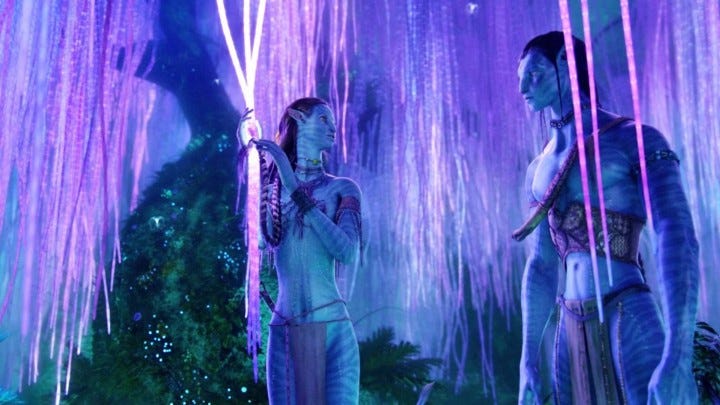by Jess Hagy
In 2009, James Cameron’s Avatar was received by critics as groundbreaking and was thought to change how films would be made with CGI and the creative way that cameras would be used. The film went on to be nominated for nine Academy Awards and won three for technical achievement. Everyone thought it was a shoo-in to win Best Director and Best Picture but those went to Kathryn Bigelow (Cameron’s ex-wife) and The Hurt Locker, respectively.
With all the success and love this film garnered when originally released, you may be asking yourselves, “Well, then why did you wait 13 years to finally sit down and watch it? It’s on Disney+.”
And to that I say…I don’t really have an answer.
I definitely didn’t want to watch it on my small computer screen because that would not do the production design nor the CGI artists justice. This film took nearly ten years to make, so I didn’t want to downplay it.
I found the biggest screen I could to watch it.
Also, as the years went by, I got scared it would not live up to the hype. And did it? There were moments where I felt like the film was exactly how I expected it would be. It seemed like this movie had been mythologized so much that it felt like I had already watched it, even though I certainly had not.
Once the story started to take place mostly on Pandora and there was more world building, it began to come off fresh, like it could’ve been released this year and gotten great reviews.
The biggest aspect of the film that I was surprised felt so relevant now in 2022 (possibly even more relevant) were the themes of race and “othering” — one demographic of people thinking it’s okay for them to destroy and then claim territory that is already inhabited by another culture. The majority of the actors playing the Na’vi (the aliens of Pandora) are actors of color and I don’t believe that casting to be coincidental. The humans (mainly played by white actors) are depicted as very stark and industrial with all the machines and weapons at their disposal, where as the Na’vi are shown being very peaceful with their bright and colorful world. When the Na’vi kill an animal, they even speak to it almost as a prayer thanking them for the role they play in the creation and survival of Pandora. Human characters sometimes refer to the Na’vi in derogatory terms that people in reality have called minorities. Cameron, as both director and writer, does this subtly throughout as to still make the film feel like a sci-fi action blockbuster.
The third act begins with the Na’vi’s home essentially being bombed and then bulldozed by the humans, causing the Na’vi to flee in horror. The humans do this because they believe the Na’vi to be less powerful just because they are different and from somewhere else. Watching this sequence reminded me of images of the riots that have occurred in recent years.
That culture and language of the Na’vi felt futuristic while also being grounded and familiar like how some cultures on Earth have lived in past centuries. This was prominent within the bonding of the Na’vi with the creatures of Pandora. The bonding ritual was forceful (when one character must find his own companion in a winged creature, he lassos its beak and mounts it in a similar way to bull riding or hog tying) while also beautiful because there is an unspoken decision between the souls of the Na’vi and nature seeming to be: I am yours and you are mine.
That with every piece of nature on Pandora that there is a soulmate within each Na’vi.
Looking back, I am glad I waited to watch and experience Avatar because I got more out of the story than I would have if I watched it as the young, naive preteen I was when it originally came out. More than a decade later, the film still had something to say about the world we live in today. The jury is still out whether the sequels will live up to the first one. I will say that even though I look forward to seeing more of the world, this movie can stand on its own.




